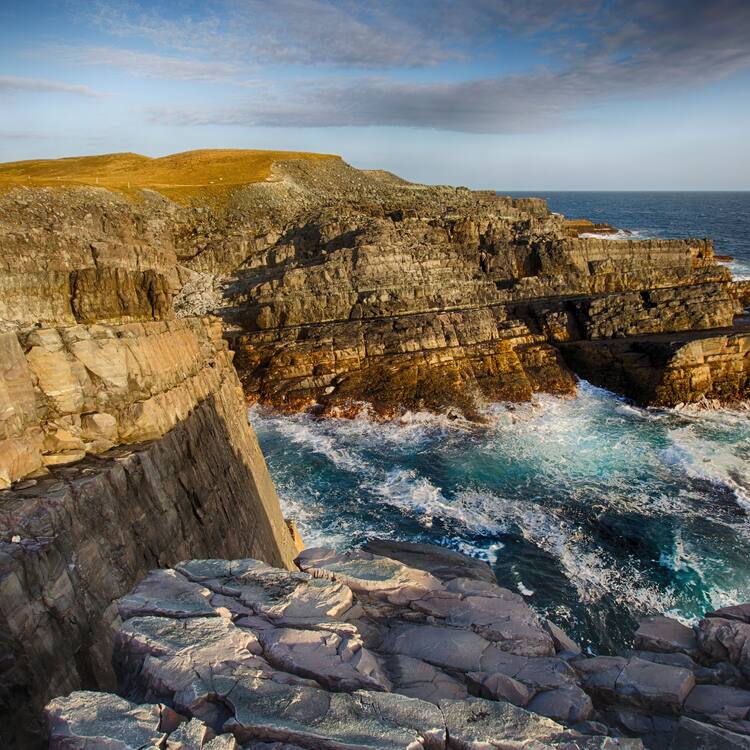Mistaken Point
Mistaken Point
This fossil site is located at the south-eastern tip of the island of Newfoundland, in eastern Canada. It consists of a narrow, 17 km-long strip of rugged coastal cliffs. Of deep marine origin, these cliffs date to the Ediacaran Period (580-560 million years ago), representing the oldest known assemblages of large fossils anywhere. These fossils illustrate a watershed in the history of life on earth: the appearance of large, biologically complex organisms, after almost three billion years of micro-dominated evolution.
Description is available under license CC-BY-SA IGO 3.0
Mistaken Point
Ce site fossilifère est situé à l’extrémité sud-est de l’île de Terre-Neuve, à l’est du pays. Il se compose d’une bande étroite de 17 km de long, formée de falaises côtières accidentées. Originaires des fonds marins, ces falaises, qui datent de la période de l’Édiacarien (580-560 millions d’années), présentent les plus anciens assemblages de grands fossiles connus. Ces fossiles illustrent un tournant critique dans l’histoire de la vie sur Terre : l’apparition d’organismes de grande taille, biologiquement complexes, après presque trois milliards d’années d’évolution dominée par les micro-organismes.
Description is available under license CC-BY-SA IGO 3.0
النقطة الخاطئة
يعتبر هذا الموقع الأحفوري الواقع أقصى جنوب شرق "جزيرة الأرض الجديدة "(نيوفاوندلاند) شرق كندا. وتتألف هذه الجزيرة من ساحل يمتد على طول 17 كم من المنحدرات الساحليّة الوعرة. ويذكر أن هذه المنحدرات التي تعود للعصور الإدياكارية (أي قبل ما يقارب 560-580 مليون سنة) تشكلت في قاع البحار وتعتبر اليوم أكبر التجمعات الأحفورية القديمة على مرّ التاريخ. والجدير بالذكر أن هذه المنحدرات تجسّد نقلة نوعيّة في التاريخ: حيث هي المكان الأول الذي ظهرت فيه كائنات ضخمة الحجم ومعقّدة التركيب البيولوجي بعد مليارات السنين من هيمنة الميكروبات.
source: UNESCO/CPE
Description is available under license CC-BY-SA IGO 3.0
迷斯塔肯角
这处化石遗址位于加拿大东部纽芬兰岛的东南尽头,是一处长达17公里的狭长地带,有崎岖的沿海峭壁地貌。这片世界上已知最古老的大型化石群可追溯至震旦纪(5亿6千万-5亿8千万年前),勾画出地球生命演化史中一个极端重要的转折:微生物主导进化30亿年后,更大、更复杂的生命体开始出现。
source: UNESCO/CPE
Description is available under license CC-BY-SA IGO 3.0
Мистейкен Пойнт
Этот богатый окаменелостями экологический заповедник расположен на юго-востоке острова Ньюфаундленд в восточной части Канады. Объект включает узкую полосу прибрежных крутых скал длиной 17 километров. Эти скалы, сформировавшиеся на морском дне в Эдиакарский период (580-560 млн лет назад), хранят самые древние из всех известных крупных окаменелостей. Эти окаменелости свидетельствуют о переломном этапе в истории жизни на Земле - появлении на нашей планете крупных и биологически сложных организмов после трех миллиардов лет эволюции, когда доминировали микроорганизмы.
source: UNESCO/CPE
Description is available under license CC-BY-SA IGO 3.0
Mistaken Point
Situado en el extremo sudoriental de la isla canadiense de Terranova, frente al litoral este del subcontinente septentrional americano, este sitio fosilífero se extiende a lo largo de una estrecha franja de 17 km. de longitud formada por acantilados abruptos. Surgidos del fondo del mar, estos acantilados datan del Periodo Ediacárico (unos 580 a 560 millones de años atrás). En ellos se pueden observar los conjuntos más antiguos de fósiles ensamblados de gran tamaño descubiertos hasta ahora, que ilustran un momento crucial de la historia de la vida en la Tierra: la aparición de organismos biológicamente complejos de grandes dimensiones, después de una fase de la evolución que duró tres mil millones de años y estuvo presidida por el predominio de los microbios.
source: UNESCO/CPE
Description is available under license CC-BY-SA IGO 3.0
ミステイクン・ポイント
エディアカラ生物群の化石が産出する断崖。ミステイクン・ポイントの化石遺跡は、カナダ東部ニューファンドランド島南東端にある17kmに及ぶ険しい海食崖である。ここで見られる厚さ2kmに及ぶ深海起源の地層は、5億8000万円前~5億6000万円前のエディアカラ紀中期まで遡り、世界最古の豊富で多様な大型化石の集合体がきわめて良い状態で保存されている。骨格を持たない体が柔らかな動物の化石が残り、単細胞生物からより複雑な無脊椎動物への変化が見られる。また、さまざまな種類の化石が同時に見られ、当時の生態系の構成を知ることもできる。source: NFUAJ
Mistaken Point
Deze fossielenvindplaats bevindt zich aan de kust op de zuidoostelijke punt van het eiland Newfoundland in Oost-Canada. De site bestaat uit een smalle, 17 km. lange, strook van ruige kliffen. De rotsen, van origine zeebodem, dateren uit het Ediacarium (580-560 miljoen jaar geleden). Het gebied bevat de oudste collectie van grotere fossielen ter wereld. Deze fossielen markeren een waterscheiding in de geschiedenis van de aarde: de verschijning van grote, biologisch complexe organismen, na ongeveer drie miljard jaar van evolutie en dominantie van micro-organismen.
Source: unesco.nl
Outstanding Universal Value
Brief synthesis
Mistaken Point is a globally significant Ediacaran fossil site almost entirely located within Mistaken Point Ecological Reserve on the south-eastern tip of the island of Newfoundland in eastern Canada. The 146-hectare property consists of a narrow, 17-kilometre-long strip of rugged naturally-eroding coastal cliffs, with an additional 74 hectares adjoining its landward margin designated as a buffer zone. The superbly exposed, 2-kilometre-thick rock sequence of deep marine origin at Mistaken Point dates to the middle Ediacaran Period (580 to 560 million years ago) and contains exquisitely preserved assemblages of the oldest abundant and diverse, large fossils known anywhere.
More than 10,000 fossil impressions, ranging from a few centimetres to nearly 2 metres in length, are readily visible for scientific study and supervised viewing along the coastline of Mistaken Point. These fossils illustrate a critical watershed in the early history of life on Earth: the appearance of large, biologically complex organisms, including the first ancestral animals. Most of the fossils are rangeomorphs, an extinct group of fractal organisms positioned near the base of animal evolution. These soft-bodied creatures lived on the deep-sea floor, and were buried and preserved in exceptional detail by influxes of volcanic ash – each layer of ash creating an “Ediacaran Pompeii.” Modern erosion has exhumed more than 100 fossil sea-floor surfaces, ranging from small beds with single fossils to larger surfaces adorned with up to 4,500 megafossils. The animals died where they lived, and their resultant fossil assemblages preserve both the morphology of extinct groups of ancestral animals and the ecological structure of their ancient communities. Radiometric dating of the volcanic ash beds that directly overlie the fossil-bearing surfaces is providing a detailed chronology for 20 million years in the early evolution of complex life.
Criterion (viii): Mistaken Point fossils constitute an outstanding record of a critical milestone in the history of life on Earth, “when life got big” after almost three billion years of microbe-dominated evolution. The fossils range in age from 580 to 560 million years, the longest continuous record of Ediacara-type megafossils anywhere, and predate by more than 40 million years the Cambrian explosion, being the oldest fossil evidence of ancestors of most modern animal groups. Mistaken Point contains the world’s oldest-known examples of large, architecturally complex organisms, including soft-bodied, ancestral animals. Ecologically, Mistaken Point contains the oldest and most diverse examples of Ediacaran deep-sea communities in the world thus preserving rare insights into the ecology of these ancestral animals and the early colonization of the deep-sea floor. Other attributes contributing to the property’s Outstanding Universal Value include the world’s first examples of metazoan locomotion, exceptional potential for radiometric dating of the assemblages, and evidence for the role of ancient oxygen levels in the regional and global appearance of complex multicellular life.
Integrity
The clearly defined property boundary encompasses coastal exposures preserving all the features that convey its Outstanding Universal Value. All of the key fossils and strata are within the property. The width of the property and its buffer zone, which in large part corresponds to the Mistaken Point Ecological Reserve, are sufficient to absorb the very gradual, long-term retreat of the coastline due to natural erosion. The natural erosion of the site will refresh the fossil exposures over time.
The vast majority of Mistaken Point’s fossils – including several type specimens – remain in situ in the field and are thus available for study in their ecological context. Several hundred fossil specimens were collected prior to Mistaken Point Ecological Reserve being established; most of these are currently housed in the Royal Ontario Museum and form the bulk of the type specimens for taxa named and defined from Mistaken Point. Nonetheless the property is thought to contain more specimens of Ediacara-type impression fossils than the sum total of every museum collection on Earth.
Few traces of past human activities remain and none directly affect the property’s key attributes. Visitation to the site is modest and strictly controlled. The prospect of modern development within or adjacent to the property is minimal and does not impinge upon its coastal outcrops. Incidents of vandalism are very rare and no successful fossil thefts have occurred since the property was designated as an ecological reserve in 1987. No inhabitants reside permanently within the property or its buffer zone.
Protection and management requirements
The property is provincially owned and is managed by the Parks and Natural Areas Division of the Newfoundland and Labrador Department of Environment and Conservation. Virtually all of the property, plus most of its buffer zone, lie within Mistaken Point Ecological Reserve which is protected under the Province’s Wilderness and Ecological Reserves Act (1980) and Fossil Ecological Reserve Regulations (2009). With one exception, the remaining portions of the property and buffer zone are protected as Crown Lands Reserves under the provincial Lands Act (1991). Only one small part (0.5 percent) of the buffer zone has been identified as private land; current and anticipated land use is complementary to the rest of the buffer zone.
The property’s key coastal exposures are further protected by the ecological reserve’s Fossil Protection Zone; access to this zone is by permit only. Undertaking activities such as scientific research at Mistaken Point requires a permit issued by the managing agency. Development is prohibited within the ecological reserve.
The comprehensive management plan developed for the property and its buffer zone is adaptive and will be revised as required. Input from local residents regarding management issues is channelled through the property’s World Heritage Advisory Council. For management purposes, the property is best treated as a finite fossil site. Except for official salvage of scientifically valuable specimens, collecting fossils is illegal. For conservation reasons, public viewing of the fossils is by guided tour only. Daily patrols of the property are conducted year-round and a volunteer Fossil Guardian Program is in operation.
The most significant threats to be managed are the ongoing issue of change resulting from natural erosion processes, and impacts of human activity. Under the monitoring plan, vulnerable fossil localities are regularly surveyed and any problems documented. The rate of erosion appears very slow and any loss of fossils to erosion may be offset by new exposures. Monitoring processes should trigger appropriately considered management responses to document fossil evidence, if any significant losses from erosion are identified. The carrying capacity of the property is limited and the cumulative environmental impact of visitation is closely monitored and limited. Limited signs and visitor access to aid presentation of the property are carefully designed and sited to avoid adverse impacts upon the property’s Outstanding Universal Value.
Through its long-term pledge to provide operational funding and staffing, the Government of Newfoundland and Labrador is committed to ensure that the highest possible standards of protection and presentation are maintained in the property.


